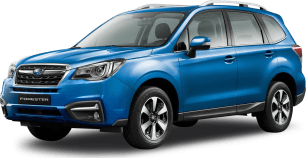The Forester range covers a lot of ground. How much a Forester costs obviously depends on the standard specification list and the accessories fitted. In this review we'll cover the RRP cost before on-roads, as opposed to drive-away price, which is listed on Subaru's website.
There are seven distinct trim levels - 2.0i-L ($30,240), 2.5i-L ($33,240), 2.0D-L ($33,740), 2.5i-S and 2.0D-S ($39,740), 2.0 XT ($41,240) and 2.0 XT Premium ($48,240). The TS sport edition is not currently in the line-up - that car had a more aggressive look with front spoiler, rear spoiler, modified suspension and was based on the XT premium package spec list, minus the sunroof.
The car is available in eight colours, all of them at no cost. They include Crystal Black, Quartz Blue, Sepia Bronze (a light metallic brown), Jasmine Green, Dark Grey, Venetian Red, Ice Silver and Crystal White. Fans of yellow are, sadly, out of luck.
It's 2017, so no Forester runs on 16-inch alloy wheels, the entry level 2.0i-L opening the bidding with 17-inch rims front and rear. Standard features include dual-zone climate control air-conditioning, a six-speed manual or CVT gearbox, remote central locking, Subaru's Starlink infotainment on a 7-inch multimedia touch screen, cruise control, AM/FM radio, CD player, bluetooth and what Subaru calls a temporary spare wheel.
Working your way up the range, the manual disappears (except on diesel models) and you'll pick up things like leather, 18-inch alloys, power tailgate, automatic door lock as you pull away, rain-sensing wipers, LED headlights, daytime running lights, panoramic sunroof, GPS navigation system, keyless entry, push-button start, performance suspension (in the XT) and a basic tool kit for tyre changes.
Unlike the old days, traditional driving lights aren't part of the list, nor are HID, projector or xenon lights. It's halogen or LED these days, with fog lights on some models.
The sound system is run by Subaru's Starlink software with between six and eight speakers, depending on the model. You can connect your iPhone or Android phone through the two USB ports but the interface is a bit old school and sometimes it's easier to use the phone itself, which is obviously not ideal. Or safe.
There are many, many dealer-fit accessories available, including, darker window tint, roof racks, rubber floor mats, boot liner, front spoiler, tow bar - the list goes on.
Aftermarket suppliers abound and can fix you up with things like a cargo barrier, a rear diffuser, additional underbody protection, a bigger rear spoiler, side steps, all manner of bodykit fitments, a snorkel, bull bar, nudge bar, seatbelt extender and, of course, a subwoofer.
There are a few gadgets missing, even at the top of the range. You won't get a heated steering wheel, Android Auto, Apple CarPlay, CD changer, DVD player, air suspension, DAB, limited slip differential or homelink technology.
Where are Subaru Foresters built? Glad you asked - Japan.
For more detailed information to compare Subaru Forester models, check out our model snapshots.






.png)











































.png)




















 copy.png)














